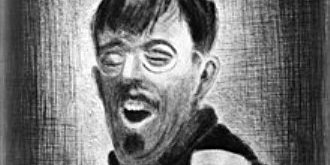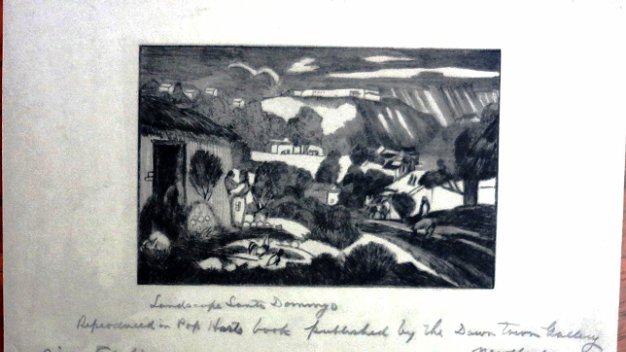George Overbury 'Pop' Hart (1868-1933). Born in Cairo, Illinois, the eldest of four children, and raised in Rochester, New York. His father managed a printing roller factory, and worked there for a time in his teens but lost the job due to an explosion that took place when he was off sketching instead of watching the glue vats. Around the age of 18 he went to London on a cattle boat and while in England became an itinerant sign painter to support himself.
Eventually he landed in Chicago, where he worked for a while as an illustrator for a newspaper and also as a sign painter for the Chicago World's Fair of 1893 and other clients. Although was initially self taught, in the 1890s he attended the Chicago Art Institute on and off for several years, and in 1907 he spent a year at the Academy Julien in Paris.
For the first few years of the 20th century traveled all over the world: Mexico, Central America, North Africa, the Caribbean, and the South Pacific, where he visited Tahiti in 1903, shortly after the death of Gauguin. Following his 1907 studies in Paris, he supported himself for about five years by working as a sign painter around New York City, and then he worked for most of a decade painting sets for the nascent film industry in New Jersey. He set up a studio in Coytesville, New Jersey, not far from Fort Lee, but he spent much of the 1920s traveling again.
He acquired his nickname of "Pop" after growing a beard during one of his many trips, and thereafter many of his works appear with the signature "Pop Hart". He died in 1933 in Coytesville, where he had lived in poor health during his last years. From his early travels onward he worked often in the highly portable medium of watercolor, and he developed a loose, vigorous style that eventually attracted the attention of Knoedler Gallery in New York, which gave him his first show. Critics have singled out his eye for detail, his technical accomplishment, and his roguish humor for praise.
After moving to the New York City area, he became part of an artist colony in Fort Lee, New Jersey, that included such champions of avant garden art as Walt Kuhn, Arthur B. Davies, and Edward Hopper. Among his close friends in New York art circles were members of the Ashcan school of social realism, especially Robert Henri and John Sloan. He painted seaside and marine subjects near his studio in Coytesville, New Jersey, as well as a wide range of other subjects including animals, botanical studies, nudes, and landscapes.
On his travels, he focused on people's daily activities and street scenes, giving those works a markedly dynamic quality that meshes well with his spontaneous, fluid brushwork. His style varies: some works show affinity with the delicate expressiveness of John Marin and Cézanne, while others lean towards the brusquer social realism of Diego Rivera or Robert Henri.
By 1921 he had taken up printmaking, working in dry point, etching, and lithography from sketches made during his trips. He also continued to work in watercolor as well as gouache and was considered one of the leading watercolor artists of his day. He was awarded a bronze medal at the Sesquicentennial Exposition in Philadelphia, Pennsylvania in 1926, and in 1935 the Newark Museum mounted a memorial retrospective exhibition of his work. His work is in the collections of the Museum of Modern Art, New York; the Brooklyn Museum; the San Francisco Museum of Modern Art; the Smithsonian Institution; the Los Angeles County Museum of Art; the British Museum, and other institutions in the United States and Europe.
However, the largest single collection of his work is held by the Zimmerli Art Museum at Rutgers University, which received some 5000 items as a gift from Hart's niece, Jeane Overbury Hart in the early 1980. The Zimmerli Museum mounted a survey show of Hart's work in 1986 to coincide with the publication of a book on Hart's life and work by Gregory Gilbert, then a research fellow in Rutgers's Department of Art History.
En español
George Overbury 'Pop' Hart (1868-1933). Nació en El Cairo, Illinois, el mayor de cuatro hermanos, y creció en Rochester, Nueva York. Su padre logró una fábrica rodillo de impresión, y trabajó allí durante un tiempo en su adolescencia, pero perdió su trabajo debido a un riesgo de explosión que tuvo lugar cuando él estaba fuera dibujando en lugar de ver las cubas de pegamento. Alrededor de la edad de 18 años se fue a Londres en un barco de ganado y mientras en Inglaterra se convirtió al pintor signo itinerante para apoyar a sí mismo.
Finalmente aterrizó en Chicago, donde trabajó por un tiempo como de ilustrador para un periódico y como un pintor de carteles para la Feria Mundial de Chicago de 1893 y otros clientes. Aunque inicialmente autodidacta, en la década de 1890 asistió al Instituto de Arte de Chicago y fuera durante varios años, y en 1907 pasó un año en la Academia Julien de París.
Durante los primeros años del siglo 20 viajó por todo el mundo: México, América Central, el norte de Africa, el Caribe y el Pacífico Sur, donde visitó Tahití en 1903, poco después de la muerte de Gauguin. Después de sus estudios en París, en 1907, él se apoyó durante unos cinco años trabajando como pintor alrededor de la ciudad de Nueva York, y luego trabajó durante más de una década, juegos de pinturas para la industria del cine naciente en Nueva Jersey. Estableció un estudio en Coytesville, Nueva Jersey, no muy lejos de Fort Lee, pero pasó gran parte de la década de 1920 viajan de nuevo.
Adquirió su apodo de "pop" después de crecer la barba durante uno de sus muchos viajes, ya partir de entonces muchas de sus obras aparecen con la firma "Pop Hart". Murió en 1933 en Coytesville, donde había vivido con mala salud durante sus últimos años. A partir de sus primeros viajes en adelante trabajó a menudo, en el medio de la acuarela, y desarrolló un estilo vigoroso suelto que atrajo eventualmente la atención de Knoedler Gallery de Nueva York, que le dió su primer show. Los críticos han señalado su ojo para el detalle, su logro técnico, y su humor pícaro para la alabanza.
Después de mudarse a la ciudad de Nueva York, se convirtió en parte de una colonia de artistas en Fort Lee, Nueva Jersey, incluida la búsqueda de campeones de arte avant garden como Walt Kuhn, Arthur B. Davies, y Edward Hopper. Entre sus amigos más cercanos en Nueva York círculos artísticos eran miembros de la Escuela Ashcan de realismo social, especialmente Robert Henri y John Sloan. Ha pintado junto al mar y temas marinos cerca de su estudio en Coytesville, Nueva Jersey, así como una amplia gama de otros temas incluyendo animales, estudios botánicos, desnudos y paisajes.
En sus viajes, se centró en las actividades diarias de las personas y las escenas de la calle, dando esas obras una calidad marcadamente dinámica que se articule con su pincelada espontánea, fluida. Su estilo varía: algunos trabajos muestran afinidad con la delicada expresividad de Juan Marín y Cézanne, mientras que otros se inclinan hacia el realismo social brusquer de Diego Rivera o Robert Henri.
En 1921 había tomado el grabado, trabajando en punta seca, aguafuerte, litografía y bocetos realizados durante sus viajes. Así continuó trabajando en acuarela y guache, y considerado uno de los principales artistas de su época de la acuarela. Fue galardonado con una medalla de bronce en el Sesquicentenario Exposición de Filadelfia, Pennsylvania, en 1926 y en 1935 el Museo de Newark montado una exposición retrospectiva conmemorativa de su obra.
Su obra se encuentra en las colecciones del Museo de Arte Moderno de Nueva York; el Museo de Brooklyn; el Museo de San Francisco de Arte Moderno; la Institución Smithsonian; el Museo del Condado de Los Ángeles de Arte; El Museo Británico, y otras instituciones en los Estados Unidos y Europa. Sin embargo, la colección más grande de su trabajo se lleva a cabo por el Museo Zimmerli Arte en la Universidad de Rutgers, que recibió unos 5.000 artículos como un regalo de la sobrina de Hart, Jeane Overbury Hart a principios del 1980. El Museo Zimmerli montado un espectáculo encuesta de la obra de Hart en 1986, coincidiendo con la publicación de un libro sobre la vida y obra de Hart por Gregory Gilbert, a continuación, un investigador en el Departamento de Historia del Arte de Rutgers.

